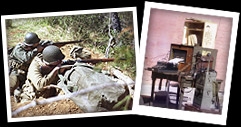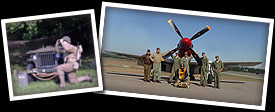Supporting Weapons in the Defense
From Army Officer's Notebook (Revised, 1943)
Heavy machine guns are distributed throughout the position. At least half of them are sited for close defense of the main line of resistance; they are usually located from 50 to 200 yards in rear thereof.
Light antitank weapons are sited for close-range defense of the main line of resistance. When available in sufficient numbers, they preferably cover mutually overlapping oblique fields of fire from emplacements masked from frontal observation. They may be assigned supplementary positions in the outpost zone.
Antitank guns are so located as to bring fire on their targets from the moment they come within effective range. They may be assigned positions in readiness near the regimental reserve, or occupy firing and cover positions behind the first mask in rear of the main line of resistance. The 81-mm mortars are located close enough to the front to have good observation of their targets, and in any case not more than 800 yards in rear of the main line of resistance.
The extreme range of the 75-mm guns varies from 8,800 yards to more than 13,000 yards. Time shells, which burst in the air, spray fragments covering effectively an area on the ground approximately 30 yards wide and 5 yards deep. The extreme range of 105-mm and 155-mm howitzers is slightly in excess of 12,000 yards. Fires are not normally placed near friendly infantry at ranges in excess of 8,000 yards from the observation post nor at ranges in excess of three-fourths of the maximum range from the pieces for the ammunition used.
Under the most favorable firing
conditions, unsheltered friendly troops should be as far from fire of guns
as follows:
75-mm 200 yards
105-mm howitzer 350 yards
155-mm howitzer 500 yards
Under less favorable conditions
the distances should be:
75-mm 600 yards
105-mm howitzer 500 yards
155-mm howitzer 800 yards
Employment of standard areas permits a uniform and expeditious system of assigning artillery concentrations.
These areas are indicated as
circles of 100, 200, 300, and 400 yards in diameter, although the actual pattern
of fire approximates a rectangle with the small dimension equal to the diameter
of the circle. The area for a given target depends upon the material, size
of the target, accuracy with which its location is known, and the probability
of the fire being checked or corrected by observation. The 200-yard circle
is generally used for neutralization fire by a 75-mm gun battery using unobserved
fire; the 100-yard circle, for observed fire on a suitable target.
Standard areas permit standard systems for preparation of fire and standard ammunition allotments. Time permitting, data are prepared for fire on areas most likely to become targets.
The capability of an artillery unit to neutralize an area depends upon the material used, time available, method of fire, size of the area, and kind of target. Guns can establish neutralization over areas as follows:
75-mm gun battery: 200-yard
area--5 minutes--112 rounds
105-mm howitzer battery: 200-yard area--same time--fewer rounds
155-mm howitzer battery: 300-yard area--7 minutes
A considerable expenditure of ammunition is required for artillery if employed for wire destruction. Depending upon the range and conditions of observation, from 600 to 1,200 rounds of 75-mm ammunition are required to cut a breach 30 yards wide through wire not exceeding 30 yards in depth. From 350 to 700 rounds of 155-mm howitzer ammunition (or a somewhat higher figure for the 105-mm howitzer) are required to cut a similar breach. Wire destruction or breaching is normally done by battery.


